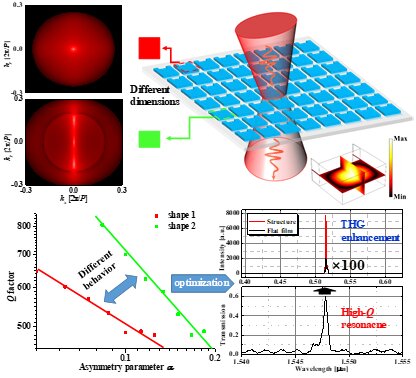#Generation and application of the high-Q resonance in all-dielectric metasurfaces

“#Generation and application of the high-Q resonance in all-dielectric metasurfaces”

In a new publication from Opto-Electronic Advances, researchers led by Professor Liu Yan from Xidian University, China and Professor Gan Xuetao from Northwestern Polytechnical University, China, consider generation and application of the high-Q resonance in all-dielectric metasurfaces.
Metamaterials are artificial composite electromagnetic structures consisting of subwavelength units, which can realize efficient and flexible control of the electromagnetic waves. Metamaterials are an emerging research area for optoelectronics, physics, chemistry and materials, due to their novel physical properties and potential applications.
With the development in the fabrication of nanostructures, all-dielectric metasurfaces have attracted much research attention because of their high efficiency and low loss. However, metasurfaces based on traditional optical materials (such as silicon) can only support relatively low Q resonances, limiting their applications in lasing action, sensing, and nonlinear optics. A recently emerged concept of bound states in the continuum (BICs) provides a new solution to overcome this problem. The concept of BICs was first introduced in quantum mechanics. It represents a wave phenomenon of modes, which have the energy lying in the delocalized states inside the continuum. The BIC-supporting metasurfaces can achieve controllable high-Q resonance, which can extend their applicability to the devices requiring sharp spectral features.
The authors of this article propose a Si metasurface based on symmetry-broken blocks, which can achieve the high-Q resonance. Nanoparticles made of conventional materials can only support a relatively low quality factor. The concept of BIC provides a new solution to overcome this problem. This concept firstly appears in quantum mechanics, where a true BIC is a mathematical abstraction with infinite Q factor. In this work, symmetry breaking is introduced into the symmetric periodic structure and the ideal BICs turn into the leaky mode with a high Q factor. At the same time, the Q factor of the resonance can be controlled by varying the size of the introduced defects. In addition, by changing the design proposal, the relationship between the Q factor and defect size can also be adjusted. A high-Q resonance can be easily realized in this way and the nonlinear optical effect of the structure can be obviously enhanced at the resonance.
The research reported in this article paves a way to manipulate BICs and realize high-Q dynamic resonances, which constitutes a significant step towards the development of high-Q resonant photonic applications. innovative and advanced optical technologies.
Looking at optical Fano resonances under a new light
Cizhe Fang et al, High-Q resonances governed by the quasi-bound states in the continuum in all-dielectric metasurfaces, Opto-Electronic Advances (2021). DOI: 10.29026/oea.2021.200030
Provided by
Compuscript Ltd
Citation:
Generation and application of the high-Q resonance in all-dielectric metasurfaces (2021, July 23)
retrieved 24 July 2021
from https://phys.org/news/2021-07-application-high-q-resonance-all-dielectric-metasurfaces.html
This document is subject to copyright. Apart from any fair dealing for the purpose of private study or research, no
part may be reproduced without the written permission. The content is provided for information purposes only.
If you liked the article, do not forget to share it with your friends. Follow us on Google News too, click on the star and choose us from your favorites.
For forums sites go to Forum.BuradaBiliyorum.Com
If you want to read more Like this articles, you can visit our Science category.




